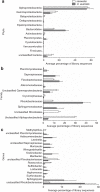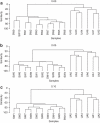Composition, uniqueness and variability of the epiphytic bacterial community of the green alga Ulva australis
- PMID: 21048801
- PMCID: PMC3105733
- DOI: 10.1038/ismej.2010.164
Composition, uniqueness and variability of the epiphytic bacterial community of the green alga Ulva australis
Abstract
Green Ulvacean marine macroalgae are distributed worldwide in coastal tidal and subtidal ecosystems. As for many living surfaces in the marine environment, little is known concerning the epiphytic bacterial biofilm communities that inhabit algal surfaces. This study reports on the largest published libraries of near full-length 16S rRNA genes from a marine algal surface (5293 sequences from six samples) allowing for an in-depth assessment of the diversity and phylogenetic profile of the bacterial community on a green Ulvacean alga. Large 16S rRNA gene libraries of surrounding seawater were also used to determine the uniqueness of this bacterial community. The surface of Ulva australis is dominated by sequences of Alphaproteobacteria and the Bacteroidetes, especially within the Rhodobacteriaceae, Sphingomonadaceae, Flavobacteriaceae and Sapropiraceae families. Seawater libraries were also dominated by Alphaproteobacteria and Bacteroidetes sequences, but were shown to be clearly distinct from U. australis libraries through the clustering of sequences into operational taxonomic units and Bray-Curtis similarity analysis. Almost no similarity was observed between these two environments at the species level, and only minor similarity was observed at levels of sequence clustering representing clades of bacteria within family and genus taxonomic groups. Variability between libraries of U. australis was relatively high, and a consistent sub-population of bacterial species was not detected. The competitive lottery model, originally derived to explain diversity in coral reef fishes, may explain the pattern of colonization of this algal surface.
Figures




References
-
- Alongi DM. Coastal Ecosystem Processes. CC Press: London; 1998.
-
- Altschul SF, Gish W, Miller W, Myers EW, Lipman DJ. Basic local alignment search tool. J Mol Biol. 1990;215:403–410. - PubMed
-
- Beleneva IA, Zhukova NV. Bacterial communities of some brown and red algae from Peter the Great Bay, the Sea of Japan. Microbiology. 2006;75:348–357. - PubMed
-
- Bell T, Newman JA, Silverman BW, Turner SL, Lilley AK. The contribution of species richness and composition to bacterial services. Nature. 2005;436:1157–1160. - PubMed
Publication types
MeSH terms
Substances
LinkOut - more resources
Full Text Sources
Research Materials

